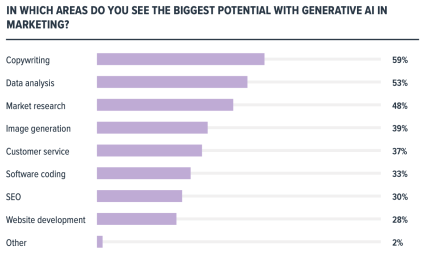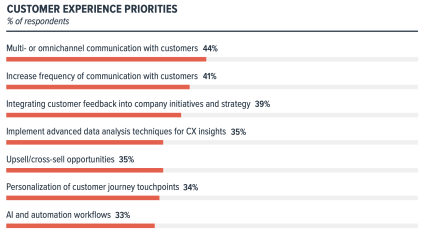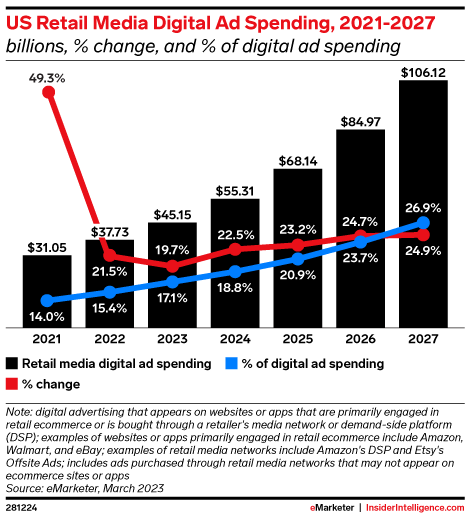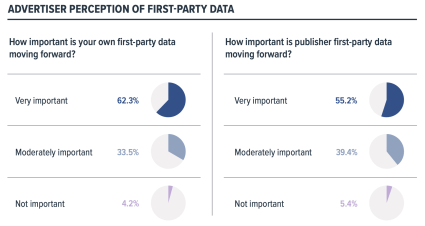From AI to data deprecation to the rise of new advertising platforms, the current trends in digital marketing are coming from every direction, rocking the entire industry, and fully changing the game. You can’t win if you fall behind.
It’s not enough to plan for the short term and look ahead to the next quarter–brands need to stay on top of the trends and keep an eye on the future to make sure they don’t miss a trick.
We’ve talked our experts into sharing their most important marketing and media predictions in our latest guide, and we’re sharing a taste of that forecast here to help you know what’s coming so you can build the most effective possible media strategy for 2024 and beyond.
AI and automation will change media as we know it
By now, we’ve all heard a lot of predictions about how AI and automation will revolutionize marketing. But what does this new technology really mean for the future of media and for your brand in 2024?
Automation and AI are already going strong in the world of paid media, with nearly 40% of marketers reporting they’re leveraging automation for paid ads in 2023 according to Ascend2. Those numbers will only increase in the next few years, especially with new advertising tools like Google’s Performance Max (PMax) and Meta’s Advantage+.
To be successful in 2024, brands will need to plan and buy media strategically with the help of AI (if they haven’t already started).
The goal should be to find the critical balance between the efficiency of AI campaigns and more expensive, in-demand premium placements. Top brands will also put a lot of human oversight in place to prevent the robots from doing more harm than good.
Generative AI will also be a game-changer for brands in 2024, optimizing everything from copywriting and image generation to SEO and data analysis. But brands will need to be strategic when they’re deploying gen AI tools. The recipe for success: the perfect blend of human and AI-assisted work to prevent errors and maximize efficiency.

Source: Mediaocean
Even if you’re not using AI yet, you should be testing out AI tools and building their potential into your planning. It’ll be time to make the switch soon, and you’ll need to be ready with the right plan and the human talent you need to create a winning AI strategy.
Stay ahead of the curve with creative marketing and great customer experience
Consumers today are looking for an authentic connection with the brands they buy from, along with a seamless journey across all touchpoints. Brands that can create experiences that resonate with their audience will rise above the rest, while others will sink.
Great creative is key to getting in touch with your audience on this personal level.
That’s especially important as data deprecation continues; as some of the most familiar audience targeting options are removed from your marketing toolkit, creative needs to act as a targeting surrogate by directly appealing to the right audience using the signals that indicate a brand or product is the best fit. Your content should offer a fresh perspective, elicit a certain feeling, or introduce something new and interesting to stand out.
Another way to make a connection with your audience is by tapping into their online communities. Consumers spend a lot of their time online, and their shared interests, inside jokes, and language are a rich source for marketers. Successful brands will take the time to listen to what their target audience cares about and transform those learnings into powerful creative assets that leverage the right language, visual style, and references to speak directly with the people who matter most to the business.
The easiest way to reach these online communities is by partnering with creators who are already a part of them. By aligning with creators who share your company’s values and who really understand your audience, you can capitalize on their connection with your customers to reach them the right way.
Once you’ve forged a relationship with your audience, you’ll need to keep them engaged by providing a seamless user experience across all your brand’s platforms. With so much competition online these days, it’s easy to lose the customers you worked so hard to pull in with one app malfunction or a challenging check-out process.

Source: eMarketer
To keep your customers on track, you need to collect data on what they’re looking for at every touchpoint and break down silos to ensure your internal teams are exchanging information to get the best end result for your audience.
Streaming TV and retail media networks will be strong forces
A successful media strategy requires prioritizing the right channels to reach your audience effectively. But the media mix is changing Search and social are still dominant, but retail media and streaming TV are both big pieces of today’s performance media pie. Leveraging them the right way will be crucial to your brand’s success.
Retail media is the hottest channel in digital right now, and will only get more important as new partnerships and players come onto the scene. To take advantage of these opportunities, you need to be testing into new networks, experimenting with new creative applications like ads in brick-and-mortar stores, and making the most of retail media networks’ expansive ad and data capabilities.

Source: eMarketer
Streaming TV is also a major source of excitement for advertisers. The rise of OTT has made TV advertising more flexible and accessible for brands, and it’s likely those opportunities will only grow. More major streamers like Netflix are offering AVOD tiers to keep consumer costs low in a fragmented market, while free-with-ads services like Tubi are leveling up their game by gobbling up more licensed content from profitability-hungry publishers like Max.
To capitalize on these streaming opportunities, you need to take an audience-first approach, paying particular attention to context: what do your customers actually want to interact with when they sit down to be entertained? It’s also important to consider how you plan to balance scale and precision as you look at the targeting options. Don’t artificially restrict your reach by over-targeting; remember that scale is one of TV’s defining superpowers.
Mature measurement and first-party data are essential in a privacy-first world
If your business is still getting by relying on an outdated strategy that runs solely on third-party data, it’s time to move on: first-party data will soon be the name of the game. The good news is that because first-party data is intentionally shared by your customers, it has the potential to be more accurate and effective than third-party data ever was.

Source: Double Verify
If you haven’t already, you need to put together a strategy prioritizing first-party data collection. You can often incentivize customers to share their data by creating a value exchange that gives them something like a discount or an interactive quiz in return. Google research found that brands can achieve consent rates as high as 85% when they ask for data in a customer-centric way.
Once you have the first-party data you need, make sure your measurement is set up for success. Measurement has always been an important aspect of marketing, but it’s becoming more and more important for brands to stand out from the pack.
Measurement needs to connect marketing spend to business objectives, but that’s challenging with new data privacy restrictions. Make sure you’re on track by evaluating your current measurement maturity and building an accountability framework to root both strategy and performance in clear business goals.
All these changes may seem intimidating, but they’re also big opportunities for marketers who are positioning their brands now to embrace them. If you’re willing to try new things, you’ll come out on top in the brave new world of performance media in 2024. The only sure way to fail is to ignore the headwinds and stick with what you’ve always done.







Responses